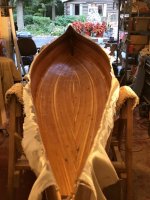Well, to throw another opinion at you......I never glass the inside with one piece. Instead, i use the roll side to side, so on a 16 footer, I usually have three main pieces, then I glass the stems individually. My canoes are work boats, I'm not concerned about glossy finishes on the inside. I put all three pieces in, smooth them out and overlap the joints by about 6 inches. Then I roll the two end pieces back a bit and put the resin to the middle piece first. The benefit of this is it is a lot easier to work out any bubbles or creases, as you just push them to the end of the piece. Difficult to describe, I probably should have taken pics at some point.
As for fill coats on the inside....waste of time and epoxy. Fill coats do not add strength nor waterproofness, but they do add weight. You will be coating the inside and out with at least three coats of varnish. However, if you want the mirror like finish on the inside, go for it. Just remember, it will add one more sanding step as you polish up the fill coats. For a wet out coat, I just do a quick rough sanding so the varnish will adhere.
Or you could go totally rogue and paint the inside. I have done that with a few of my canoes. Red of course, but green is nice too.
As for fill coats on the inside....waste of time and epoxy. Fill coats do not add strength nor waterproofness, but they do add weight. You will be coating the inside and out with at least three coats of varnish. However, if you want the mirror like finish on the inside, go for it. Just remember, it will add one more sanding step as you polish up the fill coats. For a wet out coat, I just do a quick rough sanding so the varnish will adhere.
Or you could go totally rogue and paint the inside. I have done that with a few of my canoes. Red of course, but green is nice too.





